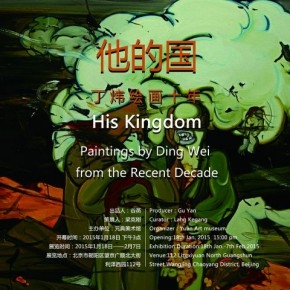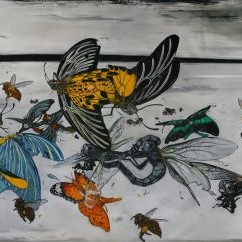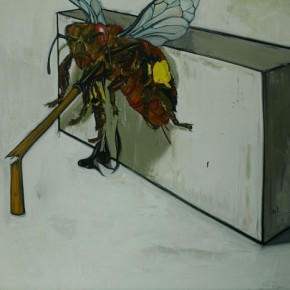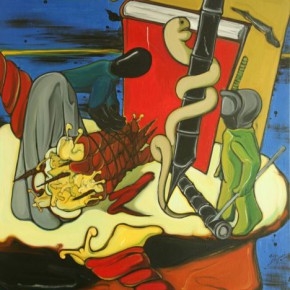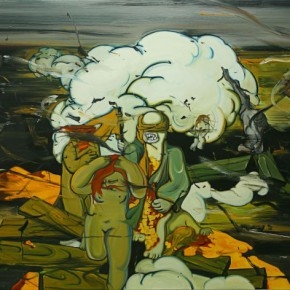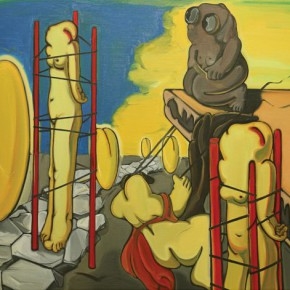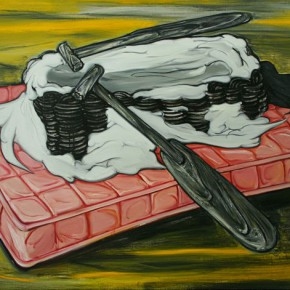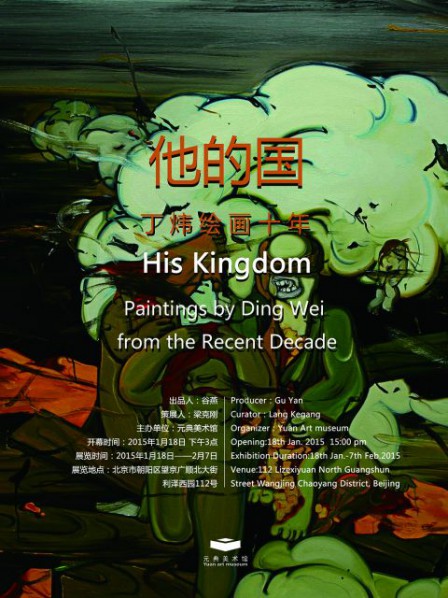
About His Kingdom–Paintings By Ding Wei From The Recent Decade
By Liang Kegang
Experiencing Vicissitudes in an Imaginative Kingdom
Ding Wei looks like a weak and humble person, but with a rich and strong heart.
Coming from a rural area of Qingdao, Ding did not have the chance to receive a formal art education. Out of the passion for painting, he, together with his friends, looked around to find teachers to help them to improve their skills in drawing. Giving continuous changing of art teachers, if not with a dedicated heart, he might have already given up his art career long time ago. He took part in the art examination in Shandong University of Arts and got the highest mark, and entered university in 1997. During his university time, he was deeply influenced by his teachers Gu Liming and Yan Ping, who knew about modernism. But he noticed the art education there still followed the Soviet mode, teachers and students focused more on technique improvement and the participation in national art exhibition. Ding always believed that art should be about soul and culture; he felt quite depressed and couldn’t find a spiritual outlet. His last year in university, in a small painting album, Ding happened to see the paintings of Fang Lijun which impressed him greatly. With the help of internet, he could get the access to the information of contemporary art which provided guidance to his later creation.
After graduating from Shandong University of Arts, Ding successfully found a job in Art Department of Qufu Normal University; hence he gradually started his career of art. In year 2004, his first opportunity to enter the contemporary art circle was by participating in an emerging artists group exhibition in Beijing organized by the famous art broker Wu Jin. Later, unfortunately, a gallery contracted with Ding didn’t provide enough support for him, which prevented his talents from known in a broader scale quickly. At that time, the art market showed favor to “cartoon” art; therefore Ding Wei was mistakenly labeled as a "cartoon" artist. The truth is that his art has nothing to do with “cartoon”. What Ding has been doing is to construct an imagined Utopia and let himself to go through the vicissitudes of life in there like a hero.
Many years ago, through a curator Guan Yuda I saw Ding’s paintings by chance, I was shocked by the first sight, later I got to meet Ding on an art activity in Yunnan. With respect to the number of influential Chinese contemporary artists born in sixties, artists born in seventies could hardly stand still before them and be unique. Yet Ding’s paintings are something fresh and different! His paintings are free from the purity shared by his peer artists, no consumerism imprint and self-pitying and cruel youth, but enriched with a sense of sorrow, history and the humanity temperament which could be rarely found in young artists. Ding’s paintings are like an ancient epic with the scenes of wars, catastrophes, sacrifice, migration and bazaars on the dark green wilderness; they also look like some kind of religious revelation, conveying a strong sense of humanistic care with tragic atmosphere. Some other works depict vulnerable butterflies and insects to express his thinking of life. He also applied many monumental symbols to reflect his reason and speculation. The painting style is deeply influenced by surrealism and expressionism. The unusual space-time and scenery are constructed on the pictures together with unrecognizable figures and animals, the paintings are not an expression or discussion on any specific thing or emotion, but rather a thinking and metaphor about man’s fate. Later I learned that Ding is a Christian, which helps me understand why many of his works have the imprint of Christian beliefs.
We contacted more in the past few years, I often went to visit Ding at his studio to see his new paintings. He likes to talk about philosophy, art and culture, every talk of us was sincere and deep, which can hardly be found in today’s eating-and-drinking dominated art circle. These few years, because of an incurable chronic disease, his appearance has been disfigured; however, one can still feel his strong and passionate heart. He has built a huge and vast imaginative kingdom with pictures; he himself is the never-say-die hero living within it. Sometimes I could have a wonderful feeling by looking at his paintings, as if I saw him riding on a horse like a knight going through those wars, catastrophes, solemn sacrifice and noisy markets. The monument standing in the open wilderness represents what he believes. Not only does he concern about human beings and the fate of the world, but about life itself. By the study and painting of butterflies, insects and some animals, he expresses compassion for the fragility of life. Another group of his works, on the contrary, are very calm and rational, like a surgeon calmly dissecting the human organs one after another in good order. Ding selectively chose to draw the objects he is interested. The fantastic expression and pure subjective time-space disposal deprive them of their natural attributes, and instantly make them look completely unrecognizable. He presents a symbol which looks like a puzzling metaphor.
This exhibition has been planned for over two years, yet I still cannot hold my joy when I prepare this exhibition and study his paintings comprehensively. I think I should say thank-you to the gallery which I thought delayed Ding’s career in art. I cannot imagine how much he would be changed by prematurely entering this excessively commercialized art market. Perhaps I should say that how fortunately he has a stable job, lives in Rizhao, a small city of Shandong far away from Beijing, and enjoys several years’ time of no- interference creation, all these factors make it possible for him to complete a personal epic with over one hundred pieces of paintings. It is a blessing that Ding was not tumbled into the market prematurely, not gaining the so-called success, which provided him opportunity and space to carry through what he started first. This exhibition is more like a summary and presentation of the past ten years’ creation, or it can be regarded as a closing celebration for his personal epic. I divide his paintings into five chapters according to the theme and features, and they are: God's Message and an Epic, Life and Circumstance, Visions and Transformations, Signs and Metaphors, Fables and Revelations. I hope these five chapters will unfold in proper order like a drama, which states Ding’s personal epic through ten years’ thinking, hard working and affection.
Let’s give thanks to God for the existence of art and artists, to the world for the love and hurt, to time for our thinking and feelings, to fate for our meeting and understanding. So let us get together at the gallery and expect the moment when the lights go off and curtain goes up.
Jan 14, 2015
About the exhibition
Dates: Jan 18, 2015 - Feb 7, 2015
Opening: Jan 18, 2015, 15:00, Sunday
Venue: Yuan Art Museum
Courtesy of the artist and Yuan Art Museum.


